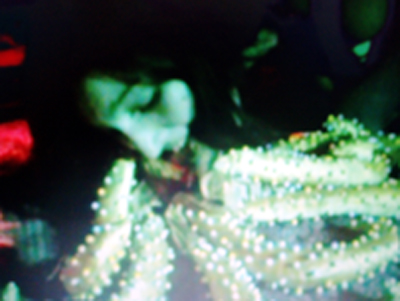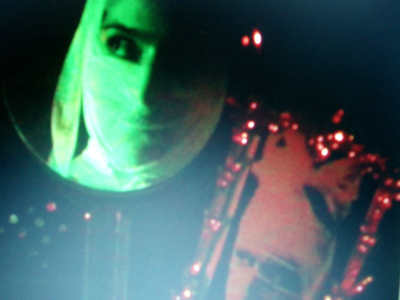Bio
Artist-researcher, with interests in the potential relationships between the theory and practice of performance, between Live Art and theatre, and between performance processes and ethical investigation. Coming from a Fine Art background (Slade School), she also has an MA in Cultural Studies (Goldsmiths College) and was Project Officer for the PARIP project (Bristol University) before becoming an AHRC Research Student on the Performing Presence Project (Exeter University). She has presented her performances and other works in a variety of contexts in the UK and abroad and is a member of the artists collective, SpRoUt http://www.sproutart.co.uk.
Research interests



My PhD research deals with the notion of presence in performance, understood as a concept at the centre of a discourse that seeks to: i) describe the nature of the relation between audience and performer* and ii) examine the values that underpin particular performances’ modes of appearance, both in terms of ways of making and ways of experiencing the performance event. How might one appear in performance? What perspective on ethics or politics might one’s mode of appearance create?
Histories of thinking presence: philosophy and performance
The research takes as its starting point the ‘heaviness’ of the term ‘presence’, overdetermined as it is by the histories of both philosophical and performance discourse. In the former, presence has an expanded significance insofar as it is used to address ontological questions concerning the nature of appearance in general, not only in the event of performance. Further, any current research seeking to engage the philosophical discourse on presence must deal not only with the term’s historical associations with notions of being, essence and transcendence, but also with the subsequent erasure of its conceptual validity by poststructuralist thinkers such as Jacques Derrida.
In terms of performance discourse, presence has been addressed in relation to various theoretical agendas over recent decades. In the early 80’s, theorists of the postmodern such as Chantal Pontbriand and Josette Feral sought to redefine presence as ‘presentness’ in order to differentiate the modes of appearance particular to ‘performance’ and ‘theatre’ as art forms, and with a view to endorsing the value of the former over the latter. In turn, the 90’s saw such claims to the purity of presence or ‘presentness’ critically revisited with the emergence of a deconstructive drive, enacted by theorists such as Philip Auslander. This saw itself as applying Derrida’s ideas as a means to reveal the logocentric assumptions at the heart of theatre’s canonical texts and works. The methods of practitioners such as Stanislavski and Grotowski, Auslander argued, naively assert the presence of the performer’s self as the foundation for acting as a practice and posit its revelation to the audience as the goal of performance, but do so without taking into account the non-identical constitution of the subject of language. Presence, he insisted, is always already mediated.
A new sense of presence?
So, then, what of presence for performance now? My research is motivated by the possibility that a more creative dialogue can be established between poststructuralist thought and the issue of presence in performance than these previous theories imply. In part, I intend to do this by shifting the philosophical focus from Derrida to Deleuze and Bataille, whose thoroughly embodied perspectives seem to me to indicate ways to think and perform a reconfigured sense of presence. This reconfiguration does not seek to deny the role of language in the constitution of the subject and hence the fact that everyday experience is mediated, but at the same time it does affirm the potential reality of encounters operating at the limits of representation through the exploration of concepts of affect, excess and sensation.
Through the research, I hope to develop a processual understanding of presence in performance as an encounter - not in the sense of an object being presented to a subject, but in terms of parallel becomings - the idea of an encounter as a parallel becoming. To become, in the Deleuzian sense, is to participate in a process which dismantles both the stable conceptual identities constructed to categorise things as different, as well as the fixed names used to label the differences between things. These identities and names constitute a frame through which the world appears to us and by which our sense of presence is informed. Deleuze asks: How might things appear to us differently without that frame? What might newly appear to us in thinking of presence as an encounter that ‘captures’ two becomings in a self-sufficient process rather than as the relationship between a subject and object or even between two subjects?
So far, so theoretical... The real challenge facing the research is to set up a parallel becoming between theory and practice with neither guiding other as ‘proof of’ or ‘blue-print for’ in a subject-object relation (with theory as subject and practice as object). Rather the research seeks to explore the processes through which practice can generate a parallel ‘practice-thought’ that resonates with Deleuze. In this regard, I am particularly influenced by the becomings that emerge from the rhizomatic, montage process of performance-making (Bottoms: 1998) developed by the Chicago-based group, Goat Island. Repeating and diverting from their model, my practice involves the collection of fragments: a still from a film by Carmelo Bene, a way of walking seen on TV, a transcription of an interview with a ‘relative of the accused’, an imagined sound. By engaging in becomings with props or site or lighting, I then hope to construct performance-encounters in which the fragments can resonate with one and other in new assemblages while also interacting with a theory of presence without merely being an illustration of that theory.
*Historically, presence discourse in performance theory has primarily addressed the question of the relation between audience and performer. Arguably though, presence also concerns the way other elements of the performance, such as props or scenography, appear.
References




